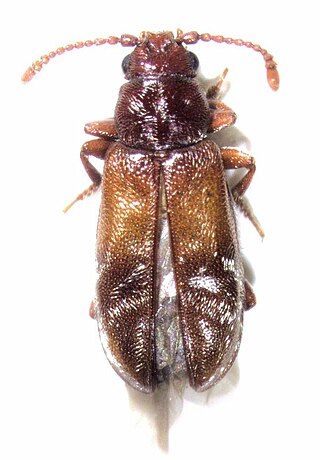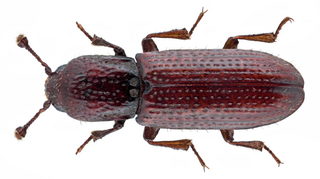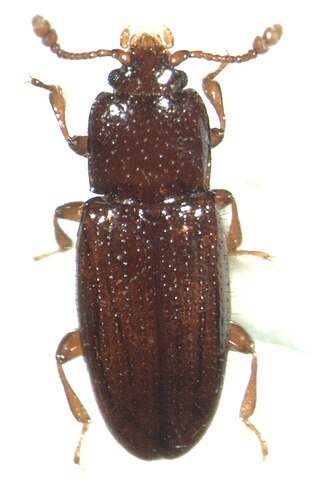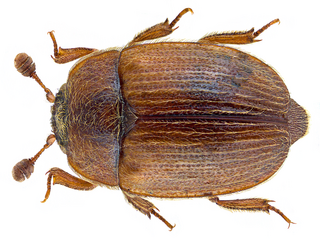
The sap beetles, also known as Nitidulidae, are a family of beetles.

Staphylinoidea is a superfamily of beetles. It is a very large and diverse group with worldwide distribution.

Colydiinae is a subfamily of beetles, commonly known as cylindrical bark beetles. They have been treated historically as a family Colydiidae, but have been moved into the Zopheridae, where they constitute the bulk of the diversity of the newly expanded family, with about 140 genera worldwide. They are diverse for example in the Australian region, from where about 35 genera are known; in Europe, though, only 20 genera are found and many of these only with few species.

Erotylidae, or the pleasing fungus beetles, is a family of beetles belonging to Cucujoidea containing over 100 genera. In the present circumscription, it contains 6 tribes and 10 subfamilies. In other words, the narrowly circumscribed Erotylidae correspond to the subfamily Erotylinae in the definition sensu lato. There are doubts on the monophyly of lower ranked taxa within Erotylidae, with further phylogenetic studies requiring better sampling and studies of unexplored character sets, for example the metendosternite and penile flagellum, which are generally lacking detailed morphological studies within the Coleoptera literature. The Eroytlina taxonomy is based on traits such as their different colors and not off morphological differences like mouthparts, thorax, and abdominal terminalia (Pecci-Maddalena).

Endomychidae, or handsome fungus beetles, is a family of beetles with representatives found in all biogeographic realms. There are around 120 genera and 1300 species. The family was established based on the type genus Endomychus, a genus erected in 1795 by Panzer which was applied to a species that Linnaeus called Chrysomela coccinea. As the common name suggests, Endomychidae feed on fungi. Crowson, in his influential treatment of the beetles, placed the family within the Cucujoidea. They have a tarsal formal of 4-4-4 or 3-3-3 and the wings lack a closed radial cell. The second antennal segment has a sensory appendage that is as long as the third antennal segment. The family has also been grouped with the Coccinellidae in a group called the Trimera for having pseudotrimerous tarsi. A 2015 molecular phylogeny study found that the Cucujoidea were found to be non-monophyletic and the Endomychidae was refined with the removal of the Anamorphinae from within the family and elevated to the status of a full family, Anamorphidae. Mycetaeinae and Eupsilobiinae were also found not to belong within the clades of the core Endomychidae, and likewise reclassified into the families Mycetaeidae and Eupsilobiidae.

Cavognathidae is a family of beetles, in the superfamily Cucujoidea. It contains a single genus, Taphropiestes with around a dozen species known from South America, Australia and New Zealand. In Australian and New Zealand species adults and larvae have been found living in bird nests, but their ecology is unclear, but they are possibly scavengers.
Hobartiidae is a family of beetles, in the superfamily Cucujoidea. There are only two known genera Hobartius and Hydnobioides, with six species, five of which are native to Australia, and one species of Hobartius native to Chile and Argentina in South America. Members of the family are mycophagous, living in rotten, fungus infested logs of Araucaria, Nothofagus, and Eucalyptus, where they feed on the fruiting bodies of basidiomycetes.

Cerylonidae are small to tiny, smooth, shiny, hairless beetles, only lightly punctured. There are about 450 species worldwide in 50 or so genera, mostly tropical and subtropical. They are most common under the bark of dead trees, but can also occur in compost and other decaying plant material. Little is known specifically about their biology but they are thought to be either predators that feed on other small animals, or fungus-feeders.
Hymaea is a genus of beetles in the family Phloeostichidae.

Monotomidae is a family of beetles in the superfamily Cucujoidea. The family is found worldwide, with approximately 240 species in 33 genera. The ecological habits of the family are diverse, with different members of the group being found under tree bark, in decaying vegetation, on flowers and in ant nests. Their ecology is obscure, while at least some species are mycophagous, feeding on the fruiting bodies of ascomycete fungi, Rhyzophagus are predators on bark beetles and possibly Phoridae larvae, with the larvae of some species also being mycophagous.

Coccinelloidea is a superfamily of beetles in the order Coleoptera, formerly included in the superfamily Cucujoidea. There are more than 10,000 species in Coccinelloidea, including more than 6000 in the lady beetle family Coccinellidae.

Carpophilinae is a subfamily of beetles in the family Nitidulidae. There are at least 70 described species in Carpophilinae.

Teredidae is a family of beetles in the superfamily Coccinelloidea, formerly included within the family Bothrideridae. There are around 160 species in 10 genera, found worldwide except South America. Teredids are generally found under bark, in the galleries of wood-boring beetles, or in leaf litter. They are thought to be fungivores. The oldest records of the family are Delteredolaemus from mid-Cretaceous aged Burmese amber from Myanmar and a species of Teredolaemus from Eocene aged Baltic amber.

Nitidulinae is a subfamily of sap-feeding beetles in the family Nitidulidae. There are about 17 genera and at least 70 described species in Nitidulinae.

Cryptarchinae is a subfamily of sap-feeding beetles in the family Nitidulidae. There are at least 3 genera and about 17 described species in Cryptarchinae.

Nitidulini is a tribe of sap-feeding beetles in the family Nitidulidae. There are about 10 genera and at least 20 described species in Nitidulini.

Philothermus is a genus of minute bark beetles in the family Cerylonidae. There are about 17 described species in Philothermus.

Pocadius is a genus of sap-feeding beetles in the family Nitidulidae. There are about nine described species in Pocadius.
Camptodes is a genus of sap-feeding beetles in the family Nitidulidae. There are about nine described species in Camptodes.















